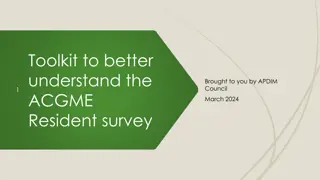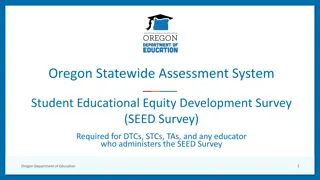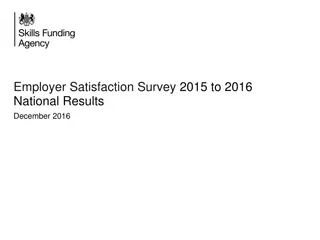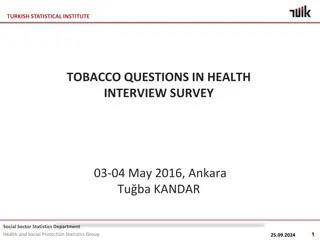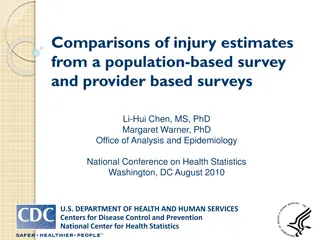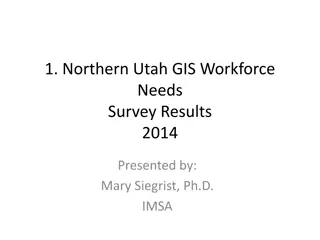
Improving Nutrition Reporting Skills: Survey of Ugandan Journalists 2019
Discover insights from a survey on Ugandan journalists' training in nutrition reporting to enhance media coverage on malnutrition issues. Gain valuable information on the challenges and opportunities faced by media professionals in addressing global nutrition concerns.
Download Presentation

Please find below an Image/Link to download the presentation.
The content on the website is provided AS IS for your information and personal use only. It may not be sold, licensed, or shared on other websites without obtaining consent from the author. If you encounter any issues during the download, it is possible that the publisher has removed the file from their server.
You are allowed to download the files provided on this website for personal or commercial use, subject to the condition that they are used lawfully. All files are the property of their respective owners.
The content on the website is provided AS IS for your information and personal use only. It may not be sold, licensed, or shared on other websites without obtaining consent from the author.
E N D
Presentation Transcript
JOURNALISTS NUTRITION REPORTING SKILLS SURVEY REPORT 2019 Presented by Presented by Richard Richard Baguma Baguma
Executive Summary Executive Summary Why the study: Why the study: limited media coverage on nutrition issues Brief Brief background: background: Malnutrition remains a pressing global challenge especially amidst the current pandemic of COVID 19. It is the leading cause of poor health and death globally accounting for 19% of all deaths ( 2020 Global Nutrition Report - 2020 GNR). Limited progress is being realized in ending malnutrition, underscoring the achievement of SDG 2 of Zero Hunger by 2030 (2019 State of Food Security and Nutrition in the World ). Uganda s Nutrition Advocacy and Communication Strategy (NACS) provides ways to increase urgency and accountability around nutrition programming, change of attitudes through community dialogue. Enhancing media capacity in understanding nutrition issues is vital and improves sound reporting on food availability, food access, and food utilization for communities.
Survey goal: Survey goal: To establish whether journalists across different regions in Uganda had had any form of training on nutrition reporting Survey objectives: Survey objectives: Finding out whether journalists had been exposed to any form of training on nutrition reporting. Establishing ways of strengthening the skills of journalists to produce stories on nutrition. Methodology Methodology Participants; Participants; journalists from various media houses Design; Design; Convenience selection Sample; Sample; a total of 200 journalists were selected. 160 responded (80% response). Survey instrument; Survey instrument; questionnaire 14 questions both open-ended and multiple-choice Data analysis; Data analysis; data was analyzed using SPSS
Gender Gender of respondents of respondents 55.6 55.6 60 44.4 44.4 50 Percentage (%) 40 Male Female 30 20 10 0 Male Female
Age bracket of respondents Age bracket of respondents 70 60 Percentage (%) 50 40 Series1 65 65 30 20 23.1 23.1 10 10 10 1.9 1.9 0 18 - 25 26 - 35 36 - 45 above 46 Interaction was with mature respondents who understood the subject of the study
T Type ype of media the of media the respondents respondents work work in in 43.1 43.1 45 40 35 30.6 30.6 Radio Percentage (%) 30 Television Newspaper 25 Blog 20 Magazine 13.1 13.1 Newsletter 15 others 6.9 6.9 10 5.6 5.6 5 0.6 0.6 0 0 0 Radio Television Newspaper Blog Magazine Newsletter others More radio journalists provided information and they understood coverage of nutrition programs and promotion of nutrition awareness
G Geographical eographical coverage of the media house the respondents coverage of the media house the respondents work with work with 13.8 13.8 International 16.9 16.9 Regional 43.1 43.1 National 26.2 26.2 Local 0 5 10 15 20 25 30 35 40 45 Percentage (%) Local National Regional International The subject of study was familiar nationwide
P Primary rimary target for media house with a local geographical target for media house with a local geographical coverage coverage Most local media houses have a primary target of central region. 8.12% 21.88% Central region Eastern region 51.88% Northern region Western region 18.12%
J Journalists ournalists work experience work experience Respondents had experience in journalism practice thus they could easily comprehend what nutrition reporting is all about 10.60% 15.60% 34.40% 39.40% 0 - 2 years 3 - 5 years 6 - 10 years above 10 years
R Respondents espondents level of education level of education 0 0.60% Distinction in education levels helped in informing how respondents easily understood the aim of the survey 9.40% Certificate Diploma Degree 32.50% Masters PhD 57.50% Others
Respondents who have had training in Journalism Respondents who have had training in Journalism Many journalists have undergone training in journalism. 9.38% Yes No 90.62%
R Respondents espondents level of training in level of training in journalism journalism 40 37.5 Majority understood the connotation of the study given their level of journalism training. 33.8 35 30 28.1 Percentage (%) 25 20 Series1 15 10 5 0 0 0 0 Certificate Diploma Degree Masters PhD Others
T Training raining on Nutrition on Nutrition Reporting Reporting A big percentage had not had any form of training on nutrition reporting much as they broadcast or publish nutrition stories 31.25% 68.75% Yes No
Type of training (if Yes) Type of training (if Yes) 0% 20.62% Workshop Seminar Certificate course Others 17.50% 61.88% Majority received training from a workshop, this kind of training is inadequate. Their expertise to produce quality and accurate nutrition stories is very minimal.
L Level evel of confidence to report on nutrition as a result of the of confidence to report on nutrition as a result of the training training 19.38% Not confident Confident 80.62% W Why lack of confidence hy lack of confidence Not knowledgeable enough even after undergoing a training Need to acquire more skills to better their nutrition reporting Need more frequent trainings because nutrition is wide and a less exploited area of reporting
F Frequency requency of publishing or broadcasting a Nutrition of publishing or broadcasting a Nutrition story story 30 26.88 25 Percentage (%) 21.25 20 Daily 20 Weekly Monthly 15 Once a Year 12.5 Quarterly 8.75 Bi-annually 10 Others 5.62 5 5 0 Daily Weekly Monthly Once a Year Quarterly Bi-annually Others Nutrition stories are published or broadcast on a monthly basis. Justifying the limited media coverage on nutrition issues.
Recommendation Recommendation for journalists to be trained on reporting about Nutrition for journalists to be trained on reporting about Nutrition 7.50% Recommend Do not recommend 92.50% Why the recommendation Why the recommendation Help in exploiting the area of nutrition and frequently giving the subject better media coverage Journalists will show people s perceptions of the subject (nutrition issues) Increase on knowledge base
Why the recommendation (contd) Why the recommendation (cont d) Trained Journalists authoritatively increase awareness about nutrition Training will make them sensitize the masses from an informed point of view Training will sharpen their reporting skills Trained Journalists will report about nutrition with more confidence It will increase on the coverage of nutrition stories; this increased coverage will lead to an informed society which will be more conscious of its nutrition habits.
Age Age Vs Vs having any training on Nutrition having any training on Nutrition Reporting Reporting 50 45.6 45.6 45 40 35 Percentage (%) 30 Yes 25 NO 19.4 19.4 20 14.4 14.4 15 8.7 8.7 6.9 6.9 10 3.1 3.1 1.9 1.9 5 0 0 0 18-25 26-35 36-45 above 46 Many young experienced journalists had not received any form of training on nutrition reporting . Contributing to limited media coverage, inaccurate and poor quality nutrition stories.
Gender Gender Vs Vs having any training on Nutrition Reporting having any training on Nutrition Reporting 39.4 39.4 40 35 29.4 29.4 Percentage (%) 30 25 Male Female 16.2 16.2 20 15 15 15 10 5 0 Yes No Both gender have a high percentage of those who have not received any form of training on nutrition reporting.
T Type ype of media respondents of media respondents work work in in Vs Vs having any training on having any training on nutrition nutrition r reporting eporting 29.4 29.4 30 25 Percentage (%) 20 18.1 18.1 Yes 13.7 13.7 15 No 12.5 12.5 10.6 10.6 10 5.6 5.6 4.4 4.4 5 2.5 2.5 1.3 1.3 1.3 1.3 0.6 0.6 0 0 0 0 0 0 0 Radio Television Newspaper Blog Magazine Newsletter Others Radio had the highest % of journalists without any form of training on nutrition reporting . Possibly due to lack of facilitation, poor pay , lack of interest
Level Level of education of education Vs Vs having any training on Nutrition having any training on Nutrition Reporting Reporting 42.5 42.5 45 40 Percentage (%) 35 30 25 Yes 19.4 19.4 No 20 15 15 13.1 13.1 15 10 6.3 6.3 3.1 3.1 5 0.6 0.6 0 0 0 0 0 0 0 0 0 0 0 Certificate Diploma Degree Masters PhD Others Journalists with degrees had not had any form of training on nutrition reporting. Trainings are likely to improve reporting skills, knowledge base
Frequency of publishing Frequency of publishing or or broadcasting a broadcasting a nutrition story respondents respondents work nutrition story Vs Vs the type of media the type of media work in in 12 11.2 10 10 10 8.1 Radio 8 Percentage (%) Television 6.8 6.8 6.2 Newspaper 5.6 6 Blog Magazine Newsletter 3.7 4 Others 2.5 2.5 2.5 1.8 1.8 1.8 1.8 1.8 1.8 1.8 1.8 2 1.2 1.2 1.2 1.2 0.6 0.6 0.6 0.6 0.6 0 0 0 0 0 0 0 0 0 0 0 0 0 0 0 0 0 0 0 0 0 Daily Weekly Monthly Once a year Quarterly Bi-annually Others Radio has the highest frequency in airing stories
T Training raining in Journalism in Journalism Vs Vs training training i in n Nutrition Nutrition Reporting Reporting 70 60.6 60 50 Percentage (%) YES (journalism) / YES (nutrition reporting) 40 NO (journalism) / YES (Nutrition reporting) 30 30 YES (journalism) / NO (nutrition reporting) 20 NO (journalism) / NO (Nutrition reporting) 8.1 10 1.3 0 YES NO YES NO (journalism) / YES (nutrition reporting) (journalism) / YES (Nutrition reporting) (journalism) / NO (nutrition reporting) (journalism) / NO (Nutrition reporting) A big percentage of journalists have been trained in journalism but not on nutrition reporting
Challenges Challenges Inadequate knowledge and absence of easily accessible information on nutrition issues Inadequate skills to produce and report nutrition stories Lack of interest from journalists on nutrition issues Inadequate support from media houses lack of opportunity or access to trainings on nutrition reporting Conclusion Conclusion Many journalists have not received any form of training on nutrition reporting have very low level of confidence in reporting nutrition stories
Recommendations Recommendations Develop a nutrition media training guide Incorporate nutrition reporting in journalism curriculum Undertake regular nutrition reporting skills training Facilitate in-depth media reporting on nutrition Provide mentorship opportunities and fellowship programs to improve reporting on nutrition. Design and disseminate media packages to strengthen nutrition reporting Advocate for support for nutrition reporting at the editorial and top management levels in the media
Thank you Thank you







